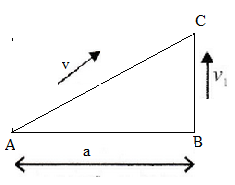
Two boys are standing at the ends A and B of a ground, where \[AB = a\]. The boy at B starts running in a direction perpendicular to AB with velocity \[{v_1}\]. The boy at A starts running simultaneously with velocity $v$ and catches the other boy in a time t, where t is:
A) \[\dfrac{a}{{\sqrt {{v^2} + v_1^2} }}\]
B) \[\sqrt {\dfrac{{{a^2}}}{{{v^2} - v_1^2}}} \]
C) \[\dfrac{a}{{v + {v_1}}}\]
D) \[\dfrac{a}{{v - {v_1}}}\]
Answer
219.6k+ views
Hint: First we see that according to the question, at which direction the boy B is moving. Then draw a figure to calculate time t at which Boy at A catches boy which runs from B. We use Pythagoras’s theorem to calculate time. According to the question, both boys are running along the sides of the right angle triangle.
Complete step by step solution:
First we draw diagram indicating directions of velocities of boys moving from A and B

Given: Width of ground, \[AB = a\], velocity of boy moving from point B=\[{v_1}\], velocity of boy moving from point A=\[v\]
From figure, directions of\[{v_1}\], \[v\] and AB are making sides of right angle triangle
Use Pythagoras theorem, \[A{C^2} = A{B^2} + B{C^2}\]......(I)
Distance AC is given by, \[AC = velocity{\text{ }}of{\text{ }}boy{\text{ }}moving{\text{ }}from{\text{ }}B{\text{ }} \times time{\text{ }}taken{\text{ }}from{\text{ }}A{\text{ }}to{\text{ }}C\]
\[ \Rightarrow AC = vt\]
Distance AB is given by \[AB = a\]
Distance BC is given by, \[BC = {v_1}t\]
Substituting values of AB,BC and CA in equation (i), we get
\[{\left( {vt} \right)^2} = {\left( a \right)^2} + {\left( {{v_1}t} \right)^2}\]
\[\begin{gathered}
\Rightarrow {v^2}{t^2} = {a^2} + v_1^2{t^2} \\
{v^2}{t^2} - v_1^2{t^2} = {a^2} \\
\Rightarrow \left( {{v^2} - v_1^2} \right){t^2} = {a^2} \\
\therefore {t^2} = \dfrac{{{a^2}}}{{\left( {{v^2} - v_1^2} \right)}} \\
\end{gathered} \]
\[ \Rightarrow t = \sqrt {\dfrac{{{a^2}}}{{\left( {{v^2} - v_1^2} \right)}}} \]
Time required for boy running from A to catches the other boy running from B is given by,
$\Rightarrow$ \[t = \sqrt {\dfrac{{{a^2}}}{{\left( {{v^2} - v_1^2} \right)}}} \]
Hence, the correct option is D.
Additional information: Pythagoras theorem describes the relation between the lengths of the sides a, b and c of the right angle triangle. This relation is called the "Pythagorean equation": This theorem is also called the Pythagorean Theorem. According to Pythagoras theorem “In a right-angled triangle, the square of the hypotenuse side is equal to the sum of squares of the other two sides“. The sides of this triangle are called Perpendicular, Base and Hypotenuse.
Note: Students must be careful about making figures according to directions of velocities. Because the correct figure calculates the write value of time. By Pythagoras theorem, only distance is calculated. Distance is calculated by velocity and time. Students must be careful to apply Pythagoras theorem and distance value.
Complete step by step solution:
First we draw diagram indicating directions of velocities of boys moving from A and B

Given: Width of ground, \[AB = a\], velocity of boy moving from point B=\[{v_1}\], velocity of boy moving from point A=\[v\]
From figure, directions of\[{v_1}\], \[v\] and AB are making sides of right angle triangle
Use Pythagoras theorem, \[A{C^2} = A{B^2} + B{C^2}\]......(I)
Distance AC is given by, \[AC = velocity{\text{ }}of{\text{ }}boy{\text{ }}moving{\text{ }}from{\text{ }}B{\text{ }} \times time{\text{ }}taken{\text{ }}from{\text{ }}A{\text{ }}to{\text{ }}C\]
\[ \Rightarrow AC = vt\]
Distance AB is given by \[AB = a\]
Distance BC is given by, \[BC = {v_1}t\]
Substituting values of AB,BC and CA in equation (i), we get
\[{\left( {vt} \right)^2} = {\left( a \right)^2} + {\left( {{v_1}t} \right)^2}\]
\[\begin{gathered}
\Rightarrow {v^2}{t^2} = {a^2} + v_1^2{t^2} \\
{v^2}{t^2} - v_1^2{t^2} = {a^2} \\
\Rightarrow \left( {{v^2} - v_1^2} \right){t^2} = {a^2} \\
\therefore {t^2} = \dfrac{{{a^2}}}{{\left( {{v^2} - v_1^2} \right)}} \\
\end{gathered} \]
\[ \Rightarrow t = \sqrt {\dfrac{{{a^2}}}{{\left( {{v^2} - v_1^2} \right)}}} \]
Time required for boy running from A to catches the other boy running from B is given by,
$\Rightarrow$ \[t = \sqrt {\dfrac{{{a^2}}}{{\left( {{v^2} - v_1^2} \right)}}} \]
Hence, the correct option is D.
Additional information: Pythagoras theorem describes the relation between the lengths of the sides a, b and c of the right angle triangle. This relation is called the "Pythagorean equation": This theorem is also called the Pythagorean Theorem. According to Pythagoras theorem “In a right-angled triangle, the square of the hypotenuse side is equal to the sum of squares of the other two sides“. The sides of this triangle are called Perpendicular, Base and Hypotenuse.
Note: Students must be careful about making figures according to directions of velocities. Because the correct figure calculates the write value of time. By Pythagoras theorem, only distance is calculated. Distance is calculated by velocity and time. Students must be careful to apply Pythagoras theorem and distance value.
Recently Updated Pages
Chemical Equation - Important Concepts and Tips for JEE

JEE Main 2022 (July 29th Shift 1) Chemistry Question Paper with Answer Key

Conduction Explained: Definition, Examples & Science for Students

Analytical Method of Vector Addition Explained Simply

Atomic Size - Important Concepts and Tips for JEE

JEE Main 2022 (June 29th Shift 1) Maths Question Paper with Answer Key

Trending doubts
JEE Main 2026: Application Form Open, Exam Dates, Syllabus, Eligibility & Question Papers

Understanding Uniform Acceleration in Physics

Derivation of Equation of Trajectory Explained for Students

Hybridisation in Chemistry – Concept, Types & Applications

Understanding the Angle of Deviation in a Prism

Understanding Collisions: Types and Examples for Students

Other Pages
JEE Advanced Marks vs Ranks 2025: Understanding Category-wise Qualifying Marks and Previous Year Cut-offs

Units And Measurements Class 11 Physics Chapter 1 CBSE Notes - 2025-26

NCERT Solutions For Class 11 Physics Chapter 8 Mechanical Properties Of Solids

Motion in a Straight Line Class 11 Physics Chapter 2 CBSE Notes - 2025-26

NCERT Solutions for Class 11 Physics Chapter 7 Gravitation 2025-26

Mechanical Properties of Fluids Class 11 Physics Chapter 9 CBSE Notes - 2025-26




